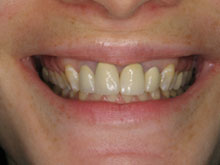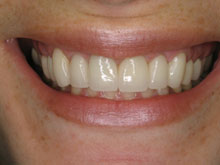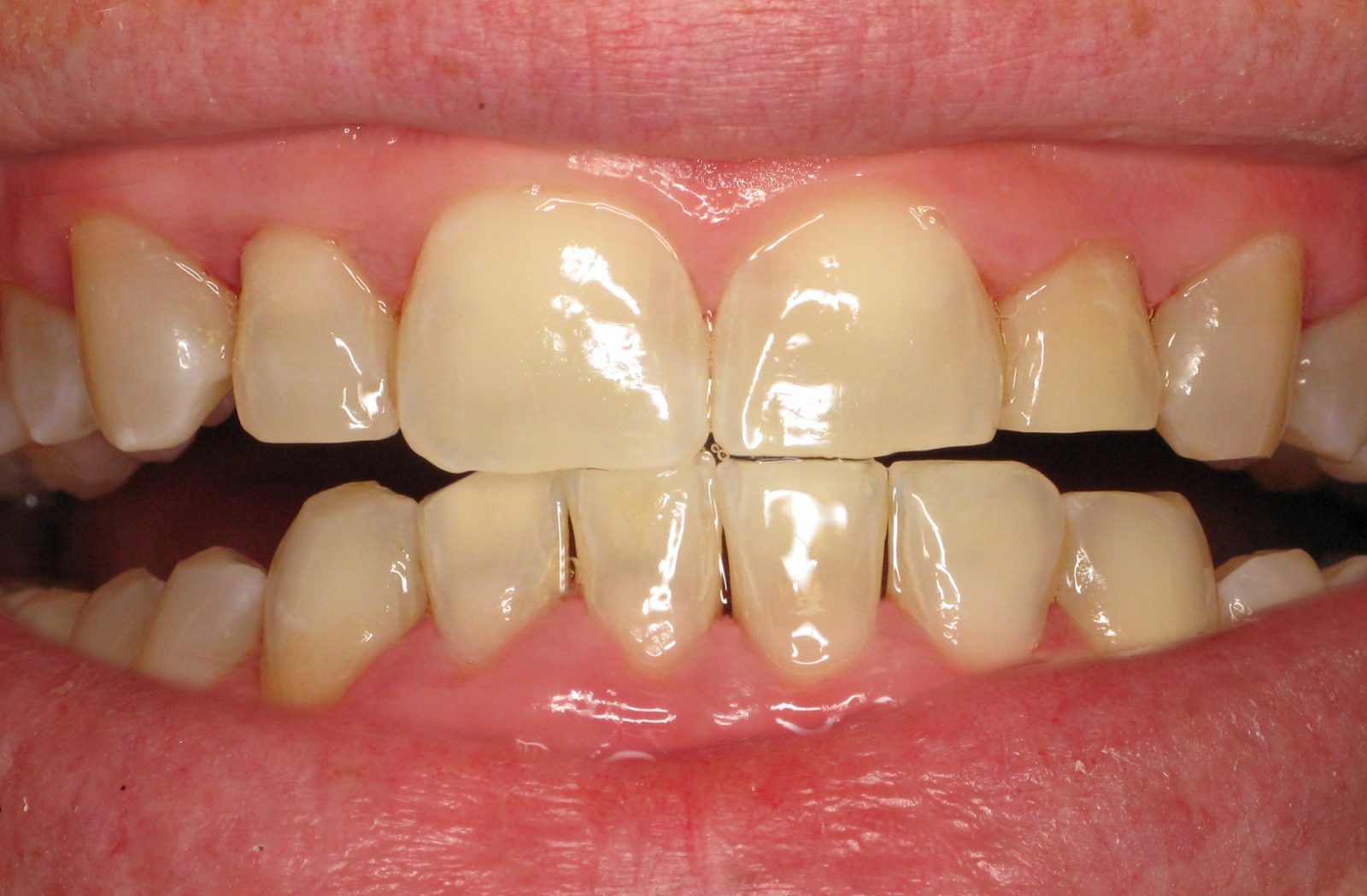Gum Disease Symptom: Gum Recession

Gum recession is a noteworthy symptom of gum disease that warrants careful attention due to its potential impact on oral health. This condition manifests as the gradual and visible lowering of the gumline, exposing the tooth roots. As gums recede, the protective tissues surrounding the teeth diminish, leaving the roots vulnerable to external elements.
The primary cause of gum recession is often gum disease, characterized by the inflammation of the gingival tissues. However, other factors such as aggressive tooth brushing, genetic predisposition, hormonal changes, and misaligned teeth can contribute to this phenomenon. Beyond the aesthetic concerns, gum recession can lead to increased tooth sensitivity, a higher risk of cavities on the exposed roots, and, in severe cases, tooth mobility.
Addressing gum recession promptly is vital for preventing further deterioration and preserving oral health, and seeking professional guidance is crucial for a comprehensive evaluation and tailored treatment plan.
How Is Gum Recession Diagnosed?
The diagnosis of gum recession involves a thorough examination by a dental professional, typically during routine dental check-ups or when a patient presents with concerns about gum health. The process is comprehensive, encompassing both visual assessments and, if necessary, more detailed evaluations. Visual inspection is the initial step, where the dentist examines the gums for signs of recession, such as a lower gumline, exposed tooth roots, or changes in gum thickness.
Periodontal probing, a common diagnostic tool, may be employed to measure the depth of periodontal pockets and assess the attachment levels of the gums to the teeth. Additionally, dental X-rays may be taken to reveal the extent of bone loss and identify potential contributing factors, such as underlying gum disease. Impressions or models of the teeth also aid in evaluating the recession’s severity and planning appropriate interventions.
The collaborative use of these diagnostic tools allows dental professionals to diagnose gum recession accurately, determine its underlying causes, and devise a customized treatment plan to address the symptoms and contributing factors. Regular dental check-ups are crucial for the early detection and management of gum recession, facilitating optimal oral health outcomes.
What methods does a periodontist use to clinically examine gum recession?
A periodontist employs various methods for the clinical examination of gum recession, combining visual assessments with more specialized techniques to comprehensively evaluate the extent and causes of the recession. Initially, the periodontist visually inspects the gums, looking for signs of recession, such as a lower gumline, exposed tooth roots, or gum texture and color changes.
Periodontal probing is a critical tool in this examination, involving using a periodontal probe to measure the depth of periodontal pockets and assess the attachment levels of the gums to the teeth. This helps determine the recession’s severity and the potential presence of underlying gum disease. Dental X-rays are crucial in providing detailed images of the teeth and surrounding bone, identifying the extent of bone loss and contributing factors. Additionally, the periodontist may use advanced imaging techniques, such as cone-beam computed tomography (CBCT), for a more detailed three-dimensional assessment. Impressions or models of the teeth may be created to visualize the changes in gum architecture and plan appropriate interventions.
By employing these comprehensive methods, a periodontist can accurately diagnose gum recession, identify contributing factors, and formulate a tailored treatment plan to effectively address the symptoms and underlying causes. Regular visits to a periodontist are essential for ongoing monitoring and optimal management of gum recession.
How is the measurement of gum tissue loss (pocket depth) conducted to diagnose gum recession?
The measurement of gum tissue loss, often called pocket depth, is a crucial aspect of diagnosing gum recession and assessing the overall health of the periodontal tissues. This process is typically performed using a periodontal probe. This thin, calibrated instrument is gently inserted into the space between the tooth and the surrounding gum tissue, known as the periodontal pocket.
During a comprehensive dental examination, the periodontist or dental hygienist systematically measures these pocket depths around each tooth. The depth of the periodontal pockets reflects the level of attachment between the gums and the tooth, with deeper pockets indicating greater gum tissue loss. In the context of gum recession, increased pocket depth signifies the exposure of tooth roots due to the receding gums. Measurements are recorded at several points around each tooth to create a periodontal chart, providing a detailed map of the gingival health.
This pocket depth assessment aids in diagnosing gum recession, identifying the severity of the condition, and determining whether underlying issues, such as gum disease, contribute to the recession. Regular monitoring of pocket depths is essential for ongoing periodontal care and the effective management of gum recession.
In what way do dental X-rays help assess bone loss related to gum recession?

Dental X-rays play a crucial role in assessing bone loss related to gum recession by providing detailed images of the teeth and surrounding structures that are not visible during a routine clinical examination. In the context of gum recession, bone loss often accompanies the recession of the gums, particularly in cases of advanced periodontal disease.
X-rays allow dental professionals, including periodontists, to visualize the supporting bone structure and identify any changes indicative of bone loss. Periapical X-rays capture images of the entire tooth, from the crown to the root and surrounding bone, providing a detailed view of the bone level and potential irregularities. Additionally, bitewing X-rays focus on specific areas of the mouth, including the crowns of upper and lower teeth, to reveal bone density and architecture changes.
Cone-beam computed tomography (CBCT) is an advanced imaging technique that offers three-dimensional views of the oral and maxillofacial structures, allowing for a more comprehensive assessment of bone loss and its impact on gum recession.
By analyzing these X-ray images, dental professionals can accurately diagnose the extent of bone loss, determine the underlying causes, and formulate an effective treatment plan for managing both the gum recession and associated bone loss. Regular monitoring through X-rays is instrumental in tracking the progression of these conditions and ensuring optimal periodontal care.
What are the Causes of Gum Recession?
Gum recession is a complex dental condition influenced by various factors, and understanding its causes is crucial for effective prevention and treatment. One primary cause is gum disease, specifically periodontitis, where bacterial infection leads to inflammation, degradation of the supporting tissues, and subsequent recession of the gums. Aggressive tooth brushing and improper oral hygiene practices can contribute to mechanical wear, leading to the gradual erosion of the gum line.
Genetic predisposition also plays a role, as some individuals may be more susceptible to gum recession. Hormonal changes, such as those occurring during pregnancy, menopause, or certain medical conditions, can also influence gum health. Misaligned teeth or a poorly fitting dental appliance may exert excessive force on the gums, accelerating recession.
Other contributing factors include tobacco use, which hampers blood flow and compromises gum health, and bruxism (teeth grinding), which can cause trauma to the gums. Understanding the multifaceted causes of gum recession is fundamental in adopting preventive measures and seeking timely intervention to preserve gum health and overall oral well-being.
How do periodontal infections and bacterial growth contribute to gum recession?
Periodontal infections and bacterial growth are primary contributors to the development of gum recession. The process often begins with gingivitis, an early stage of gum disease characterized by inflammation of the gums due to the accumulation of bacterial plaque. If left untreated, gingivitis can progress to periodontitis, a more severe form of gum disease.
In periodontitis, the bacterial infection extends beyond the gumline and infiltrates the supporting structures, including the periodontal ligaments and alveolar bone. The immune system responds to this infection with an inflammatory reaction, leading to the degradation of these supportive tissues.
As the infection persists, the breakdown of collagen fibers and bone loss occurs, causing the gums to recede. The periodontal pockets formed by separating the gums from the teeth become ideal environments for continued bacterial growth, exacerbating the cycle of inflammation and tissue destruction. This prolonged inflammatory response and bacterial assault contribute significantly to the progressive recession of the gums.
Effective management of periodontal infections through professional dental care, meticulous oral hygiene practices, and timely intervention is crucial in preventing and mitigating gum recession associated with bacterial growth.
What role do poor oral hygiene habits play in causing gum recession?
Poor oral hygiene habits are pivotal in causing gum recession, representing a significant risk factor for this dental condition. When individuals neglect regular and thorough oral care practices, such as brushing, flossing, and routine dental check-ups, harmful bacterial plaque accumulates along the gum line and between teeth.
Over time, this plaque hardens into tartar, creating an environment conducive to the development of gum disease. Bacterial plaque and tartar trigger an inflammatory response in the gums, initiating a gradual breakdown of the supportive tissues. As the gums become more susceptible to infection and inflammation, they start to recede, exposing the tooth roots.
Moreover, poor oral hygiene practices can lead to abrasive tooth brushing, causing mechanical wear and tear on the delicate gum tissues, further accelerating the recession process. Consistent and effective oral hygiene and regular professional dental cleanings are essential in preventing gum recession. Adopting proper oral care habits not only promotes gum health but also serves as a key preventive measure against the detrimental effects of poor oral hygiene on the supporting structures of the teeth.
Are genetics and family history contributing factors to gum recession?
Genetics and family history can indeed be significant contributing factors to gum recession. Individuals may inherit certain genetic traits that influence the thickness and resilience of their gum tissues. Some people may be genetically predisposed to have thinner gums, making them more vulnerable to recession. Additionally, the immune response and how the body reacts to bacterial challenges in the oral cavity can have a genetic component, impacting susceptibility to gum disease.
If a person’s parents or close relatives have experienced gum recession, there may be a hereditary link that increases the likelihood of similar issues in subsequent generations. While genetics play a role, it’s essential to recognize that environmental factors, oral hygiene practices, and lifestyle choices also significantly contribute to gum health. Individuals with a family history of gum recession should be particularly vigilant in maintaining optimal oral hygiene, attending regular dental check-ups, and adopting preventive measures to mitigate genetic predispositions and promote overall gum health. If you have a family history of gum recession, call (877) 440-3564 to schedule a consultation with our Laser Periodontics & Gum Surgery specialists.
How does aggressive tooth brushing lead to gum recession?

Aggressive tooth brushing can lead to gum recession by subjecting the delicate gum tissues to excessive force and mechanical trauma. Brushing their teeth too vigorously or using a toothbrush with hard bristles can result in abrasive friction against the gums. This constant friction and pressure can damage the outer layer of the gums, causing them to recede over time.
The abrasive action not only wears away the protective enamel but also erodes the gum tissue, making it more prone to inflammation and recession. Additionally, aggressive brushing can lead to the formation of notches or grooves at the gumline, known as toothbrush abrasion, further contributing to gum recession. Once exposed, the roots of the teeth lack the protective enamel covering, making them vulnerable to temperature sensitivity and increased risk of decay.
To prevent gum recession caused by aggressive tooth brushing, it is crucial to adopt a gentle brushing technique, use a soft-bristled toothbrush, and employ proper oral hygiene practices.
What impact does tobacco use have on causing a gum recession?
Tobacco use, whether through smoking or smokeless forms, has a detrimental impact on gum health and is a significant contributor to gum recession. The harmful chemicals in tobacco products impede blood flow to the gums, compromising their ability to receive essential nutrients and oxygen. This diminished blood supply weakens the immune response, making the gums more susceptible to infections, particularly gum disease.
Smoking is a well-established risk factor for periodontal disease, and individuals who smoke have been shown to exhibit higher rates of gum recession compared to non-smokers. The inflammatory response triggered by tobacco use exacerbates the breakdown of the supporting structures, accelerating the recession of the gums. Additionally, tobacco use hampers the effectiveness of periodontal treatments and compromises the success of interventions aimed at managing gum recession.
Quitting tobacco is crucial in preserving gum health, preventing recession, and reducing the overall risk of periodontal disease. Seeking professional guidance and adopting comprehensive oral care practices are essential for individuals looking to mitigate the impact of tobacco use on their gum health and overall well-being.






